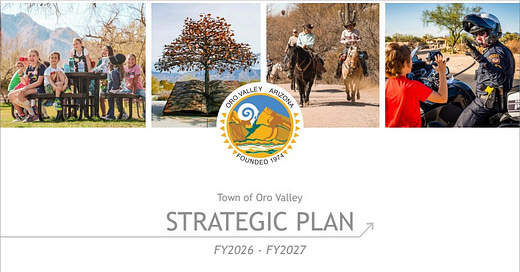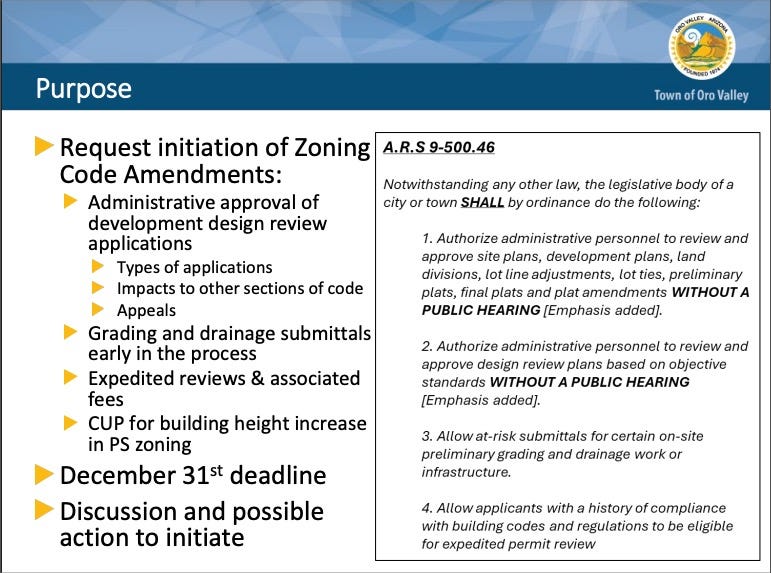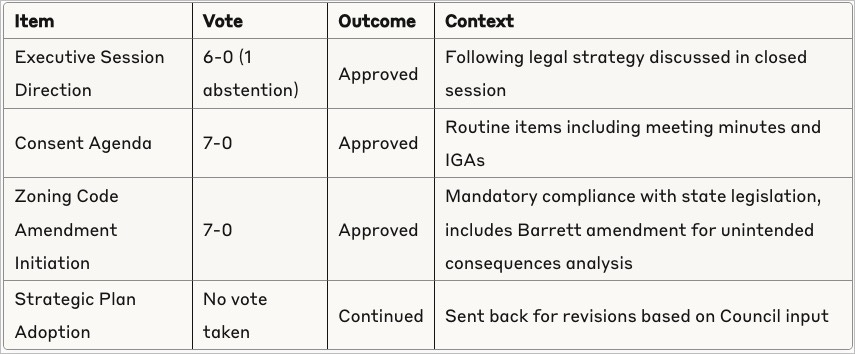💰 Budget Reality Check: Oro Valley Cuts 2.5% While Promising "Fair and Competitive" Police Deal | ORO VALLEY 5.21.25
Fiscal constraints meet public safety priorities as town navigates economic headwinds. Arizona strips away public hearings, one desert town fights back with creative community engagement.
😽 Keepin’ It Simple Summary for Younger Readers
👧🏾✊🏾👦🏾
🏘️ Oro Valley's town leaders came together to discuss significant upcoming changes in their community. 🏛️ The state government introduced new rules 📝 that prevent public meetings for new constructions, meaning the town can no longer have sessions where neighbors can ask questions or suggest changes. They can only give a yes or no based on written rules. The town council is concerned 🤔 because they believe residents should have a say in neighborhood developments.
🏗️ At the same time, the town has been actively involving residents 🗣️ in planning for the next decade, with over 100 people participating in numerous meetings to help shape Oro Valley's future. 📅 The police union and town leaders are also collaborating to agree on fair pay and benefits, 🤝 and there's optimism that they'll reach a positive agreement soon. 😊 Despite financial constraints 💸 and the state's challenging decisions, the town is finding innovative ways to continue listening 👂 to residents' preferences while adhering to the new regulations. 📏
🗝️ Takeaways
🚫 State overreach eliminates public hearings - Arizona now requires administrative approval for development projects that previously needed community input
👥 Massive community engagement success - Over 100 residents participated in 25 meetings to create Oro Valley's 10-year plan with 31 goals, 83 policies, and 241 actions
🤝 Police negotiations showing progress - Union president reports "great progression" toward agreement after productive meetings with council members
💸 Tight budget reality - $147.1 million budget down 2.5% forces prioritization of core services while maintaining public safety commitments
🏗️ Creative resistance to state mandates - Town strengthening design standards and maintaining neighborhood meetings to preserve community input despite legal restrictions
🌵 Environmental stewardship persists - Desert ecosystem protection and dark sky preservation remain priorities amid development pressures
📊 Data-driven governance - Strategic plan shifts from vague objectives to 35 specific, measurable projects with clear timelines
Democracy in the Desert: How Oro Valley's Town Council Navigates Community Priorities in an Era of State Overreach
When power moves from the people to the state house, what happens to local democracy?
The May 21, 2025, Oro Valley Town Council meeting provided a fascinating case study of how municipal governments adapt to increasingly restrictive state mandates while still trying to serve their communities' needs.
Speaker Analysis: Voices of Governance and Community
The Power Players
Mayor Joe Winfield emerged as the meeting's conductor, orchestrating discussions with practiced efficiency while demonstrating deep institutional knowledge about municipal operations. His interventions consistently pushed for specificity and accountability, particularly evident in his detailed suggestions for the strategic plan's economic vitality section.
Vice Mayor Lauren Barrett proved to be the meeting's fiscal watchdog and procedural conscience. Her repeated concerns about financial commitments and unintended consequences of policy changes revealed a systematic approach to governance that prioritizes long-term sustainability over short-term gains. Barrett's probing questions about the administrative approval changes showed a deep understanding of how state mandates can undermine local democratic processes.
Town Manager Jeff Wilkins served as the administrative bridge between policy and implementation, providing crucial context about budget realities and operational constraints. His updates on grants, business developments, and infrastructure projects painted a picture of a municipality actively pursuing growth while managing resources carefully.
Department Heads and Staff
Principal Planner Malini Sims delivered a comprehensive presentation on the "OV's Path Forward" initiative, demonstrating the town's commitment to resident-driven planning. Her detailed explanation of the community engagement process—involving over 100 residents in 25 meetings—showcased a genuine attempt at participatory democracy.
Principal Planner Frank Spath presented perhaps the meeting's most consequential item: mandatory changes to zoning approval processes due to state legislation. His presentation revealed the tension between local control and state mandates, forcing the town to approve development projects that previously required public hearings administratively.
Assistant Town Manager Carl Shadek guided the strategic plan discussion with methodical precision, emphasizing the shift from objectives to specific, measurable projects. His facilitation revealed an administration focused on accountability and transparency.
Community Voice
Christopher Knapp, President of the Oro Valley Police Officers Association, provided the meeting's only public comment. His brief but pointed remarks about labor negotiations demonstrated how public-private partnerships require ongoing dialogue and compromise.
Agenda Deep Dive: Democracy Under Pressure
Executive Session: The Clifton Matter
The meeting began with an executive session regarding the "Clifton litigation matter"—a reminder that even in transparent governance, some discussions must occur behind closed doors. The subsequent 6-0 vote (with one abstention) to follow executive session directions suggests Council unity on legal strategy, though the public remains necessarily in the dark about specifics.
OV's Path Forward: Participatory Planning in Action
Malini Sims presented an impressive example of community-driven planning. The initiative engaged over 100 residents across four working groups, generating:
31 goals
83 policies
241 actions
The process demonstrated remarkable transparency. Meeting recordings and discussion notes were published online, allowing the broader community to follow along.
Key Statistics:
Over 3,000 comments collected through 93 pop-up events
2,000 additional online comments
900 comments provided through online discussions during Phase 2
Statistically projectable phone survey to all Oro Valley adults
State Mandates vs. Local Control: The Zoning Dilemma
Michael Spaeth's mandatory zoning code changes presentation represented the meeting's most troubling development.
New state legislation requires administrative approval for "non-discretionary" applications—essentially removing public input from development decisions that were previously subject to Planning Commission and Town Council review.
Applications Moving to Administrative Approval:
Master Development Plans
Preliminary Plats
Architecture Review
Alternative Parking Ratios
Sign Criteria
Minor Communication Facilities
Vice Mayor Barrett's concerns proved prescient: "I'm a little bit concerned about the financial commitment that some of these things entail... It's like saying we are going to do this without knowing if we have the funding to do this."
The state's rationale appears focused on expediting development and reducing costs for builders, but at what cost to democratic participation? As Barrett noted, neighborhood meetings have historically resulted in "win-win solutions" where developers make minor adjustments to address community concerns.
The Council's Response: The unanimous 7-0 vote to initiate the required code amendments included Barrett's amendment to "identify other areas with unintended consequences and possible methods of mitigating those areas"—a small act of resistance against state overreach.
Strategic Planning: Balancing Aspirations with Reality
The proposed FY25-27 Strategic Plan revealed a municipality grappling with growth pressures, infrastructure needs, and fiscal constraints. The plan's structure—35 projects with 24 scheduled for FY26 completion—suggests an administration learning to underpromise and overdeliver.
Focus Areas:
Economic Vitality
Culture and Recreation
Public Safety
Infrastructure and Town Assets
Effective and Efficient Government
Financial Stability
Mayor Winfield's suggestions for economic vitality reflected sophisticated understanding of municipal economics, particularly his emphasis on addressing retail leakage—the phenomenon where local spending flows to neighboring communities instead of staying in Oro Valley.
Votes Summary: Democratic Decisions in Action
The voting patterns revealed a Council operating with unusual unanimity, though the lack of dissent may reflect the constrained choices imposed by state mandates rather than genuine consensus.
Financial Implications: Following the Money
The budget discussions revealed a municipality operating under increasing fiscal pressure:
Total FY26 Budget: $147.1 million (down 2.5% from the previous year)
NERDS Project Grant: Additional $1.5 million awarded (total now $3 million)
Police Facility Planning: Multi-year timeline with funding sources to be identified
Vice Mayor Barrett's consistent concerns about financial commitments reflected a sobering reality: municipalities can no longer assume growth will generate sufficient revenue to fund expanding service expectations.
The Environmental Subtext
Throughout the meeting, environmental considerations lurked beneath surface discussions. Despite development pressures, the invasive plant species management program, dark sky lighting protections, and desert ecosystem preservation language revealed a community still committed to environmental stewardship.
The discussion of annexing state lands particularly highlighted tensions between growth and conservation, an issue that will likely intensify as climate change impacts the Sonoran Desert ecosystem.
Labor Relations: Progress Behind Closed Doors
Christopher Knapp's public comment provided a rare glimpse into police labor negotiations that typically unfold away from public scrutiny. Speaking as President of the Oro Valley Police Officers Association, Knapp delivered what amounted to a diplomatic status update that revealed sophisticated labor-management relations.
What Knapp Said
Knapp's statement was brief but substantive, focusing on three key points:
"Since the last council meeting, we've had the opportunity to meet with members of council, which went great, led to some great meetings with members of council and management, and has caused great progression towards reaching a mutually agreed upon resolution."
His tone was notably collaborative rather than adversarial—a significant departure from the often contentious public posturing common in police union negotiations nationwide.
The Strategic Postponement
The union's request to remove the MOU discussion from the May 21st agenda was itself revealing. Rather than using the public forum to apply pressure, both sides agreed to continue negotiations privately with a target of presenting a "mutually agreed upon memorandum of understanding that's been signed" by June 4th.
This approach suggests several important dynamics:
Mature Labor Relations: Both sides appear committed to problem-solving rather than public theater
Fiscal Pressure: With the FY26 budget totaling $147.1 million (down 2.5%), negotiations likely focus on sustainability rather than major increases
Timeline Urgency: The July 1st fiscal year start creates natural pressure for resolution
Financial Context and Implications
Town Manager Wilkins characterized the budget as "generally flat" while emphasizing that it "prioritizes our core service, public safety infrastructure, and other essential operations." This language suggests the town is acknowledging public safety as a priority, even within constrained resources.
The fact that negotiations are described as seeking a "fair and competitive" solution indicates that both sides recognize regional labor market realities. In an era of nationwide police recruitment challenges, Oro Valley appears focused on retention and competitiveness rather than cost-cutting.
What's at Stake
Police labor negotiations in any municipality involve complex balancing acts between:
Officer compensation and benefits vs. fiscal sustainability
Community service expectations vs. operational realities
Regional competitiveness vs. local taxpayer burden
The collaborative tone from both Knapp and town leadership suggests recognition that sustainable public safety requires partnership rather than adversarial relationships.
Broader Implications
This approach to labor negotiations starkly contrasts the antagonistic relationships between police unions and municipal governments that have characterized many communities nationwide. The emphasis on "shared understanding" and "mutually agreed upon resolution" suggests Oro Valley has developed more mature institutional relationships.
¿Es posible una relación laboral que sirva tanto a los trabajadores como a la comunidad? The Oro Valley approach suggests it is, though the real test will come in implementation and long-term sustainability.
The June 4th timeline both sides have committed to will provide an important indicator of whether this collaborative approach produces substantive results or merely delays difficult decisions.
Democratic Participation Under Siege
Perhaps the meeting's most significant theme was the erosion of local democratic participation. The state's mandate for administrative approval of development applications represents a fundamental shift from community input to developer convenience.
This isn't just about zoning—it's about who gets to shape our communities.
Vice Mayor Barrett's observation that neighborhood meetings have historically produced "win-win solutions" highlighted what's being lost: the opportunity for residents to influence development in their own neighborhoods.
Looking Forward: Resistance Through Innovation
Despite state constraints, Oro Valley's leadership demonstrated creative approaches to maintaining community engagement:
Strengthening design standards to compensate for lost public hearings
Maintaining neighborhood meeting requirements even when not legally required
Implementing comprehensive community engagement in long-term planning
The OV's Path Forward initiative particularly stands out as a model for meaningful public participation that goes beyond minimal legal requirements.
Hope in the Desert
While this meeting revealed troubling trends in state-local relations, it also demonstrated a municipal government committed to creative problem-solving and genuine community engagement. The extensive resident participation in long-term planning, the careful attention to fiscal responsibility, and the thoughtful approach to mitigating state mandate impacts suggest Oro Valley's democratic institutions remain resilient.
Democracy isn't just about voting—it's about ongoing participation in the decisions that shape our daily lives. This Town Council meeting showed both the challenges facing local democracy and the innovative ways communities can respond.
The real test will come in implementation: Can Oro Valley maintain meaningful community engagement while complying with state mandates? Can they balance growth pressures with environmental stewardship? Can they address resident needs while maintaining fiscal sustainability?
Your voice matters in answering these questions. Local government works best when residents stay engaged beyond election cycles. Whether it's attending neighborhood meetings, participating in working groups like OV's Path Forward, or simply staying informed about Council decisions, your participation strengthens democratic governance.
What are your thoughts on this analysis? We'd love to hear from you in the comments below!
Discussion Questions:
How should municipalities balance state compliance requirements with community input when the two conflict? Should towns like Oro Valley openly resist state mandates that limit public participation, or focus on creative workarounds within existing legal frameworks?
Is extensive community engagement like the OV's Path Forward initiative truly representative democracy, or does it primarily amplify the voices of residents with time and resources to participate? How can local governments ensure that planning processes include diverse perspectives across economic, racial, and social lines?
Have a scoop or a story you want us to follow up on? Send us a message!









